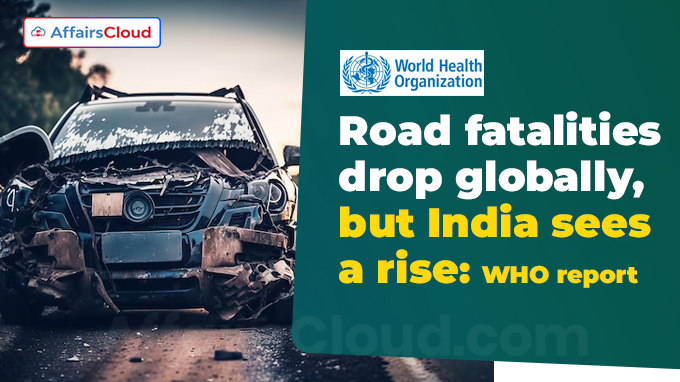 The World Health Organisation (WHO) launched the report titled “Global Status Reports on Road Safety 2023”, which shows that the annual number of road traffic deaths across the world has slightly decreased to 1.19 million from 1.25 million, marking a 5% decrease in 10 years between 2010 and 2021.
The World Health Organisation (WHO) launched the report titled “Global Status Reports on Road Safety 2023”, which shows that the annual number of road traffic deaths across the world has slightly decreased to 1.19 million from 1.25 million, marking a 5% decrease in 10 years between 2010 and 2021.
- The reduction occurred amid a doubling of the global motor vehicle fleet, expanding road networks, and nearly a billion increase in the global population.
- The 2023 report provides an overview of progress between 2010 and 2021. This is the 5th edition in the series published since 2009.
About the Report:
i.The Global Status Report on Road Safety 2023 details the scale of global road traffic deaths and progress in advancing laws, strategies, and actions to reduce them.
ii.It establishes a baseline for the United Nations (UN) Decade of Action for Road Safety 2021-2030, aiming to halve road traffic deaths and injuries by 2030.
iii.The findings of this report are based mainly on a survey and review of legislation in which 170 UN Member States and 2 territories participated.
- The report includes Country Profiles for the 24 Member States that did not directly participate.
Points to note:
i.As of 2019, road traffic injuries are the primary cause of death for those aged 5-29, and the 12th leading cause of death globally when all ages are considered.
ii.In India, the total number of road traffic fatalities went up from 1.34 lakh in 2010 to 1.54 lakh in 2021. India’s share in global road fatalities has also increased from 11% to 13%.
Countries and Regions Achieved in Global Road Safety:
i.Reductions in the number of road traffic deaths were observed in 108 countries between 2010 and 2021.
ii.10 countries have achieved in reducing road traffic deaths by over 50%. They are: Belarus, Brunei Darussalam, Denmark, Japan, Lithuania, Norway, Russian Federation, Trinidad and Tobago, The United Arab Emirates(UAE), and Venezuela.
- In addition, reductions of 40–49% were observed in 15 countries; 30–39% in 20 countries; and 20–29% in 33 countries.
iii.The European Region has the highest concentration of countries aligning with the safe system approach.
- The Western Pacific Region is 2nd both in adopting aspects of the safe system approach and achieving a noteworthy reduction in fatalities.
Note: The European Region reports the largest drop in deaths since 2010, a 36% decline, and the Western Pacific Region reports a 16% decline.
Fatalities by User Groups:
i.Over 50% of fatalities are among pedestrians, cyclists, and motorcyclists, particularly in low and middle-income countries.
ii.Globally, 53% of all road traffic fatalities are vulnerable road users including:
- 4-wheel vehicle occupants (30%); pedestrians (23%); riders of powered 2- and 3-wheeler users such as motorcycles (21%); cyclists (6%); and users of micro-mobility devices such as e-scooters (3%).
Vulnerabilities and Road Ratings:
i.Vulnerable road users such as pedestrians, cyclists, and motorcyclists are disproportionately affected.
ii.Nearly 80% of assessed roads fall below a minimum 3-star rating for pedestrian safety.
iii.As cyclist fatalities rise, only 0.2% of assessed roads have dedicated cycle lanes.
Global Burden:
i.Globally 9 in 10 deaths occur in low- and middle-income countries and disproportionately higher fatalities considering vehicles and roads.
ii.The risk of death is 3 times higher in low-income than high-income countries, yet low-income countries have just 1% of the world’s motor vehicles.
Regional Distribution of Global Road Traffic Deaths:
- 28% of global road traffic deaths occurred in the WHO South-East Asia Region;
- 25% in the Western Pacific Region;
- 19% in the African Region;
- 12% in the Region of the Americas;
- 11% in the Eastern Mediterranean Region; and
- 5% in the European Region.
Global Deficiency:
i.Only 6 countries align with WHO best practices for all risk factors (speeding, drunk–driving, motorcycle helmets, seatbelts, and child restraints).
ii.Shockingly, 140 countries (two-thirds of UN Member States) have regulations meeting WHO standards for at least one risk factor.
iii.Notably, 23 countries adjusted their laws to align with WHO best practices since the 2018 Global Status Report on Road Safety.
Recent Related News:
According to “Road Accidents in India-2022”, the annual report published by the Ministry of Road Transport and Highways (MoRTH). The States and Union Territories (UTs) of India reported a total of 4,61,312 road accidents during 2022.
About World Health Organisation (WHO):
Director General– Dr Tedros Adhanom Ghebreyesus
Headquarters– Geneva, Switzerland
Founded on– 7 April 1948




